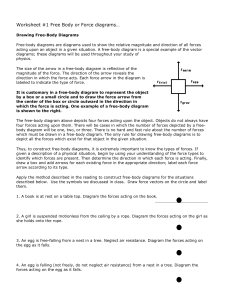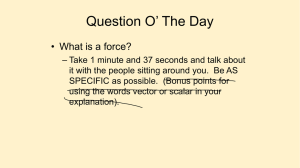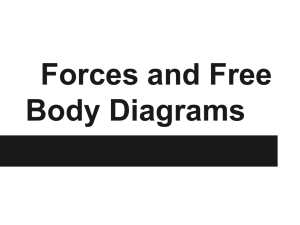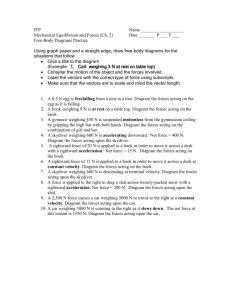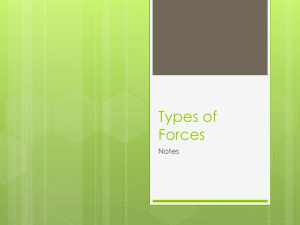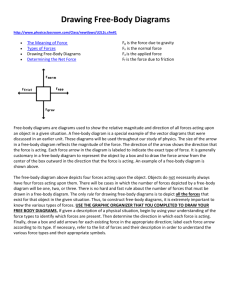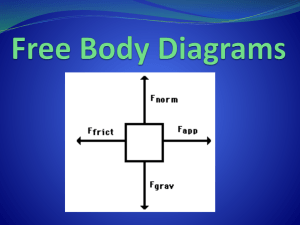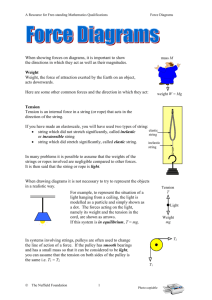Free Body & Force Diagrams Worksheet: Physics Practice
advertisement
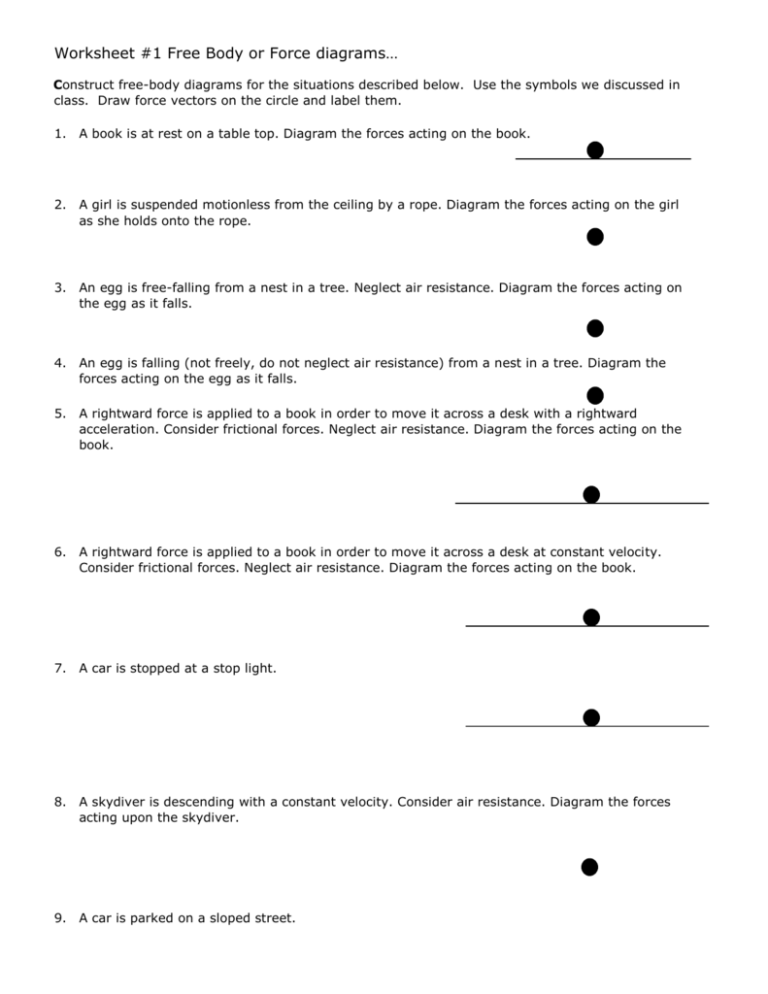
Worksheet #1 Free Body or Force diagrams… Construct free-body diagrams for the situations described below. Use the symbols we discussed in class. Draw force vectors on the circle and label them. 1. A book is at rest on a table top. Diagram the forces acting on the book. 2. A girl is suspended motionless from the ceiling by a rope. Diagram the forces acting on the girl as she holds onto the rope. 3. An egg is free-falling from a nest in a tree. Neglect air resistance. Diagram the forces acting on the egg as it falls. 4. An egg is falling (not freely, do not neglect air resistance) from a nest in a tree. Diagram the forces acting on the egg as it falls. 5. A rightward force is applied to a book in order to move it across a desk with a rightward acceleration. Consider frictional forces. Neglect air resistance. Diagram the forces acting on the book. 6. A rightward force is applied to a book in order to move it across a desk at constant velocity. Consider frictional forces. Neglect air resistance. Diagram the forces acting on the book. 7. A car is stopped at a stop light. 8. A skydiver is descending with a constant velocity. Consider air resistance. Diagram the forces acting upon the skydiver. 9. A car is parked on a sloped street. 10. A hot air balloon is accelerating upward. 11. A car is coasting to the right and slowing down. Diagram the forces acting upon the car. Name Date Pd Worksheet 2, Drawing Force Diagrams In each of the following situations, represent the object with a dot. Draw and label all the forces using standard force symbols as learned in class. 1. Object lies motionless on a surface. 2. Object slides at constant speed along a Smooth (frictionless) surface. 3. Object slows due to friction (rough surface). 4. Object slides on a smooth incline. 5. Friction on an incline prevents sliding. 6. An object is suspended from the ceiling. 7. An object is suspended from the ceiling. 8. The object is motionless. 9. The object is motionless. 10. The object is motionless. Worksheet, Drawing Force Diagrams 1 9/23/2009 11. The object is pulled by a force parallel to the surface. The surface is rough or has friction. 12. The object is pulled by a force at an angle to the surface. The surface is rough. 13. The object is pulled upward at constant speed. 13. A hot air balloon is held down to keep it From accelerating upward. 15. The object is falling (no air resistance). 16. The object is falling at constant (terminal) velocity. 17. The ball is rising in a parabolic trajectory. Do not neglect air resistance 18. A rocket is accelerating straight upward. 19. A skier is accelerating down a slope. There is friction and air resistance. 20.A big block of mass M is attached via a string to a smaller block of mass m. A student attaches a string to block M and pulls everything to the right along the rough surface. Both blocks travel at constant velocity. Do force diagrams for each block separately. Worksheet, Drawing Force Diagrams 2 Advanced Physics, Unit 6 Worksheet 3: Forces 1. Compare and contrast contact vs field forces. Give examples of each. 2. How do we calculate the weight of an object? 3. What is the weight of a 40 kg object? 9/23/2009 4. What would be the weight of the 40 kg object on the moon? 5. What changes depending on location in the universe, mass or weight? Explain. 6. What is Newton’s First Law? 7. Galileo used a term called INERTIA. What is inertia? 8. Make sure you know symbols for common forces. 9. Why is a tensional or a normal force called a support force? 10. How are tensional forces created? 11. In what direction is the weight vector always drawn? 12. What is the normal force? 13. In what direction is the normal force drawn? 14. Express Newton’s second law in symbol form. 15. Why do we write Fnet = ma and not F=ma? 16. In terms of forces, what does it mean for an object to be in ‘equilibrium?’ 17. What type(s) of motion does an object in equilibrium have? 18. How does that motion change for the object if the forces on the object are unbalanced? 19. One common way of phrasing Newton’s third law is action-reaction. What is meant by this? 20. Is gravity considered a contact or a field force? Explain.
